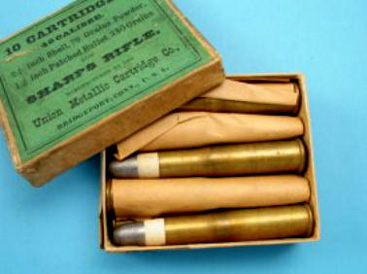

 The Accurate Reloading Forums
The Accurate Reloading Forums  THE ACCURATE RELOADING.COM FORUMS
THE ACCURATE RELOADING.COM FORUMS  Guns, Politics, Gunsmithing & Reloading
Guns, Politics, Gunsmithing & Reloading  Cartridge Collecting
Cartridge Collecting  Why Winchester choose the .277"?
Why Winchester choose the .277"?Go  | New  | Find  | Notify  | Tools  | Reply  |  |
| One of Us |
do anyone know why Winchester decide to use a .277" bullet when a 7mm was easier? I have the theory that Winchester do not want to copy the 7x64mm...... Thanks Martin Double Rifle Shooters Society member from Argentina. My doubles: .577 Snider by W.Richards. .58" ML by Pedersoli | ||
|
| one of us |
Martin I think you've partially answered the question. We'll never know for sure but I believe that Winchester did not want to duplicate anything then being done in Europe. And there was a general disdain in the US toward the "millimeter" calibers. It wasn't until 1955 and the adoption of the 243W and 244Rem that any "millimeter" bullet really caught on. Even then neither Winchester nor Remington would go all the way and call them 6mm. The original version of the 243 Winchester was called the 6mm Winchester but a last minute marketing decision changed the name. But, you'll notice that boxes of 243 Winchester ammunition were labeled "243 Winchester (6mm)" for a long time after 1955. When Remington finally realized the mistakes in the 244 they took the big leap and the 6mm Remington was the result. Ray Arizona Mountains | |||
|
| one of us |
Ray I seem to recall that Winchester was contract loading ammo for the Chinese at that time, and that ammo also used a .277 bullet..........Humm, what to do with all the tooling used to produce .277 bullets, once the contract is done with......... | |||
|
| One of Us |
Thanks Ray and Tailguner. According with what I read China Government tried first the 7x57mm Mauser and then a 6,8x57mm around 1907. Finally decide to adopt the 8x57mm. Tailguner, RWS and Roth made ammo for the 6,8x57mm but could not find any info about Winchester. Would you please tell me where can I find it? Im working on an article on the .270 Win. and I would want to ad this info. Thanks Martin Double Rifle Shooters Society member from Argentina. My doubles: .577 Snider by W.Richards. .58" ML by Pedersoli | |||
|
| one of us |
Martin I'm basing my comment on things I remember (when my memory works) reading here and there, and can't point you toward a definative source (at the present time). I was hoping that my comment would/will jog Ray's memory. Ray has forgotten more about the history of some cartridges than I've ever known. | |||
|
| one of us |
tailgunner You are right about the "forgetting" part. Martin, I don't think I can add anything more than what you've already found out. Roth, FN, and DWM all loaded 6.8 ammunition for the so called "Chinese Mauser". Bullet diameters varied .276 in the FN, to .279" in the others. Case length also varied from 57 to 60mm but they were all basically the same otherwise. I don't have any specific knowledge of where you might find information about Winchester loading ammunition. But if I had to guess, I'd say it was for the 6.8x57mm or 6.8x60mm Chinese Model 1907 and 1908. Probably a military contract. The others (FN and Roth)were basically hunting cartridges and I doubt if there would have been enough sales for Winchester to get involved. But, I'm only guessing. Ray Arizona Mountains | |||
|
| One of Us |
Ray, Tailgunner, thanks for the info.! It sounds good. Thanks Martin Double Rifle Shooters Society member from Argentina. My doubles: .577 Snider by W.Richards. .58" ML by Pedersoli | |||
|
| One of Us |
I actually suspect that it is merely as simple an error as someone wanted a 7mm and just got the conversion of the calibre to imperial measurements wrong! No more no less! In a post-WWI world where the "British" called a 7x57 a .275" and in an America where 7.65mm and 9mm Browning were called .32" and .380" nothing would surprise me! These theories about "Chinese" calibres are probably interesting but sometimes the truth is just simple mis-reading, mis-interpretation or mis-calculation. Confusing bore diameter with land diameter or some such over re-calculating five and six groove barrel drawings. Just like the infamous "Enfield Inch" http://www.rsaf-aa.co.uk/rsaf/heritage/rsaf_enfieldinch.html:
And, from another website, this: Throughout history there have been many different inches. These have been different in actual length as well as different by definition. Among the most recent ones were the British inch, the Cape inch (South African), the Enfield inch the USA inch, and the Canadian inch that subsequently became the international inch that most people use these days. I think that the inch you are referring to is the Enfield inch that was used for the design and manufacture of British weapons – an Enfield inch was a little smaller than a 'standard' inch at that time; it was about 0.9997 British inches. As an example of its use consider the Enfield 303 rifle; its bore was measured as the decimal fraction, 0.303, of an Enfield inch. | |||
|
| Powered by Social Strata |
| Please Wait. Your request is being processed... |
|
 The Accurate Reloading Forums
The Accurate Reloading Forums  THE ACCURATE RELOADING.COM FORUMS
THE ACCURATE RELOADING.COM FORUMS  Guns, Politics, Gunsmithing & Reloading
Guns, Politics, Gunsmithing & Reloading  Cartridge Collecting
Cartridge Collecting  Why Winchester choose the .277"?
Why Winchester choose the .277"?

Visit our on-line store for AR Memorabilia

